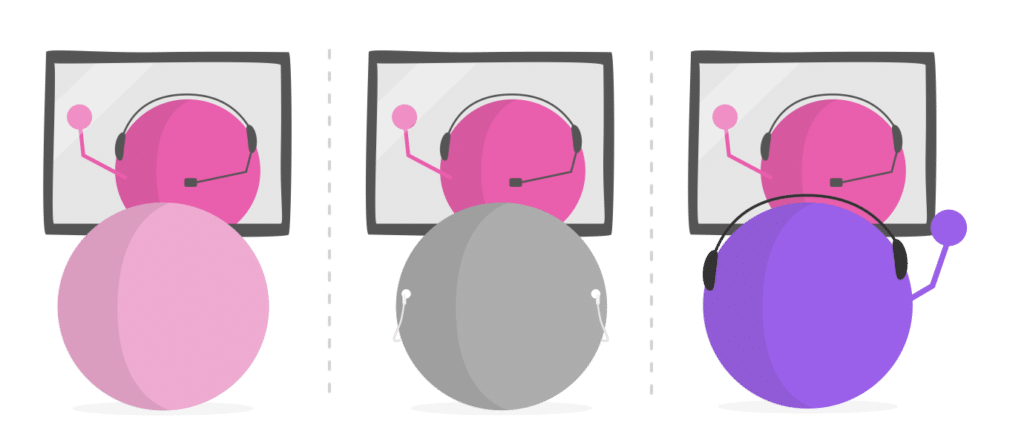Rapid User Testing with $0 Budget
In this blog; free templates!
I’ve performed a lot of user tests throughout my career using some standard user testing templates to help me. I’ve worked with participants from every type and size of organization from startup to enterprise and everything in between. There are a couple of comments that I hear regularly during these sessions:
Candidate: “This is great. I wish my company did more user testing…”
Me: “What’s stopping you?”
Candidate: “We just don’t have the budget/time/resource.” 😞
The other scenario I commonly hear is:
Candidate: “I like how you run these sessions. I should get our designer to sign up for a user test with you so they can see how you perform them.”
We have a small but growing team at ProdPad, so being able to test something quickly, learn from it, iterate, and then test again is really important. It enables us to keep up the pace at which startups need to move, and it enables me personally to keep ahead of our Development team – and keep them fed with a constant supply of features and improvements that we know our users want.
In this blog, I aim to highlight the tools that I use to perform my user tests to show that you don’t have to break the bank to start this kind of work.
Design
In order to perform a user test, you first need something that you want to learn from. You don’t need a finished, high-fidelity design to user-test a theory, you can do it with paper and pens at the most basic level. Just draw rough sketches of an interface on a piece of paper, and then take photographs of the pages. These can then be linked together using wireframing tools, allowing users to navigate through a workflow made up of rough drawings. It’s enough to start learning from.

Many designers use Balsamiq to create low-fidelity wireframes to use in their testing sessions. A free, open-source alternative to this is called Pencil, and it comes fully equipped with basic shapes and many common interface components and controls so that users can simply drag and drop and create an interface design in minutes.
All of my interface designs start off life as simple sketches in a notebook, and then evolve into a Pencil interface design, before reaching high-fidelity for hand-over to Development.
Free Tools for Design
Pencil – $0 https://pencil.evolus.vn
Pen, paper and a phone camera – $0 (assuming you have a phone and access to basic stationery)
Wireframing
Once you have an idea of the workflow(s) that you wish to user-test and have designs/sketches for each of the screens in the workflow, there are a number of tools that will allow you to sequence these together in order to test your assumptions. They will also allow you to identify the troublesome areas of the design.
I primarily use Marvel for this, it’s a tool that allows users to upload images (of any fidelity) and then sequence them together with invisible hotspots. Test candidates can then navigate through the images and you can observe their interactions.
It is a very feature-rich tool, with the ability to have not only click-interactions, but hover, fixed elements, transition animations, and more. It’s very simple for even complete novices to use, with very little difficulty in terms of a learning curve.
Marvel offers a free plan with users able to have two active projects at any time.
A popular (and probably more well-known) alternative to Marvel is InVision. The two tools are fairly similar in terms of wireframing functionality, and it’s purely down to personal preference as to which tool suits you.
Free Tools for Wireframing
Marvel Free plan – $0 https://marvelapp.com
InVision Free plan – $0 https://invisionapp.com
Test Preparation
Once you have a suitable wireframe that covers the interactions that you would like to user-test, then it’s time to write your user-test tasks.
I use a template for user testing, where I can write a scenario and task details, with space available for note-taking and the ability to grade each task so that I can capture both qualitative and quantitative data from all participants.
I use Google Docs to write these user-test documents, which is free to use
Free Tools for Test Preparation
Google Docs – $0 docs.google.com
Recruiting User Test Candidates
Organizations have a variety of procedures for product teams to contact their customers. In my previous companies, I have had difficulty in getting permission from account managers and such to invite their customers to take part in user testing. At ProdPad we have a very open and direct line of communication between the company and customers, so it’s much easier for me to recruit user-test candidates than the experience that some of you may have.
That being said, there are a few basic tools that I use to recruit user-test candidates and manage sessions.
Calendly is a tool that integrates directly with whatever calendar that you use (Google Calendar for me). It allows you to create an ‘Event’, set a date and time, a meeting place (virtual or physical), duration, and more. Once an event has been created, you simply send it to your potential candidates by whichever means are available to you (email is likely the primary form of communication for most companies).
I take the approach that user-test candidates are helping us out, so I am extremely flexible and accommodating with regard to availability. Candidates are able to book themselves into my calendar at whatever time is convenient, and regardless of what I am doing, I will drop it and perform the test, as they have offered their time to us.
Another method for recruitment is Slack. ProdPad has nurtured an amazing ProdPad Slack Community and has a very engaged customer base. When I have a feature or product improvement that I wish to user-test, I can post a message to the community with my Calendly event link, and am guaranteed to get a handful of customers who are willing to participate. You only need a handful of candidates in order to start learning and spotting commonalities between tests. It’s definitely worth checking out what communities exist in your industry or in the problem space you’re supporting, and see if anyone is willing to offer you their time.
Free Tools for Recruiting Test Candidates
Calendly Basic plan – $0 https://calendly.com
Email – $0 https://mail.google.com
Slack – $0 https://slack.com
Remote User Test
As with most companies these days, ProdPad has customers in all corners of the globe. This means that the most efficient way of performing user tests is remotely.

The majority of user tests that I perform are moderated, and I sit in remotely on the session with the candidate.
I use a couple of basic tools to facilitate this. I use Google Hangouts as the remote video conferencing tool to perform the user tests. It allows for video and audio, as well as screen sharing and text-based messaging. Of course, many of us are now using Zoom, which is an alternative to using Google’s tools.
I use a tool called OBS (Open Broadcaster Software) alongside this, it allows me to record the video and audio from my computer so that I can facilitate the user test without any distractions. It also means I can review and take notes from the session at a later date.
Free Tools for Remote User Testing
Google Hangouts – $0 https://hangouts.google.com/
Zoom – $0 https://zoom.us/
OBS – Open Broadcaster Software – $0 https://obsproject.com/
Reviewing User Tests
After a session has finished and I’ve saved and exported the OBS video file, it’s time to review the session. You will first need a media player to do this, with VLC being one of the best available.
I then take notes against each of the tasks in the original user test Google Doc and grade each task.
In order to visualize the quantitative data (task grades), I copy the tasks and grades into a Google Sheet and create a chart from the data. This shows which tasks users were able to complete successfully and immediately highlights any problem areas.
Free Tools for Reviewing User Tests
VLC Player – $0 https://www.videolan.org/vlc/index.en-GB.html
Google Sheets – $0 https://docs.google.com/spreadsheets/
It’s easy to get started
When you’re just starting out, consider doing user tests on specific, small, changes, and with some of your internal stakeholders first, so you can get used to the process and iron out the wrinkles. You don’t need to spend a lot of time on each test – maybe only 10-15 minutes. This will help you have more confidence when you start talking to customers and make the whole thing run according to plan. In general, I find that customers are keen to share their thoughts, and are happy to be listened to, so see this as a way you can hone your product skills in a structured way.
To summarize, it really isn’t as hard to get going with user testing as you’d expect. The cost doesn’t have to be high, and if you practice beforehand, you’ll soon know what you’re doing.
Sign up here to get our free user testing templates
If you want to learn more about how ProdPad supports the design team, check out our article on How ProdPad Fits with Design